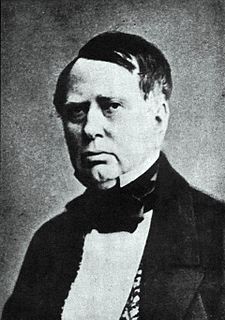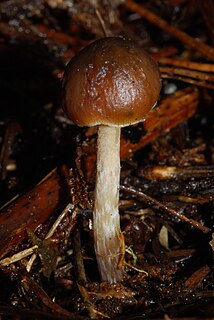
José Mariano Arista was a noted veteran of many of Mexico's nineteenth-century wars. He served as president of Mexico from 15 January 1851 to 6 January 1853. He was the first president of Mexico to be born in the 19th century.

Nissan Versa is an automobile nameplate used by the Japanese manufacturer Nissan in the Americas for the following models:

Fukuisaurus is a genus of herbivorous ornithopod dinosaur that lived during the Early Cretaceous in what is now Japan. The type species is F. tetoriensis, which was named and described in 2003.

Zuñi Salt Lake, also Zuni Salt Lake is a rare high desert lake, and a classic maar, located in Catron County, New Mexico, United States, about 60 miles (97 km) south of the Zuni Pueblo, New Mexico.

The 379th Air Expeditionary Wing is a provisional United States Air Force unit assigned to Air Combat Command. As a provisional unit, it may be activated or inactivated at any time.

The Chamela-Cuixmala Biosphere Reserve is a nature reserve on the Pacific coast of the Mexican state of Jalisco. The park was founded in 1993 and covers 131.42 square kilometres in La Huerta Municipality. The land is mountainous and contains dry tropical forest and rolling hills and alluvial plains.

At the 1968 Summer Olympics in Mexico City, four diving events were contested during a competition that took place at the Francisco Márquez Olympic Pool, from 17 to 26 October, comprising 81 divers from 21 nations.
Highway 379 is a highway in the Canadian province of Saskatchewan. It runs from Highway 4 near Wymark to Township Road 132 near McMahon and South Gnadenthal. Highway 379 is about 18 km (11 mi) long.
USS Roselle (AM-379) was an Auk-class minesweeper acquired by the United States Navy for the dangerous task of removing mines from minefields laid in the water to prevent ships from passing. She was the second United States Navy warship to be so named.

Psilocybe aucklandiae is a species of agaric fungus in the family Hymenogastraceae known from the Auckland Region of New Zealand, where it grows from clay soils in exotic pine plantations and native forests. It is phylogenetically similar to or almost the same as Psilocybe zapotecorum from Mexico and South America. As a blueing member of the genus Psilocybe it contains the psychoactive compounds psilocin and psilocybin.
CanAm Highway is an international highway that connects Mexico to Canada through the United States. It travels along U.S. Route 85 (US 85) and Interstate 25 (I-25), passing through six U.S. states and the Canadian province of Saskatchewan. The CanAm highway in Canada comprises Saskatchewan Highway 35, SK 39, SK 6, SK 3, and SK 2. The route continues south in Mexico as Mexican Federal Highway 45, and north in Canada as SK 102 but are not labeled the CanAm highway.

Progreso is one of the 38 municipalities of Coahuila, in north-eastern Mexico. The municipal seat lies at Progreso. The municipality covers an area of 1818.3 km².

The 379th Expeditionary Operations Group is a provisional United States Air Force unit assigned to the United States Air Forces Central. It is the flying component of the 379th Air Expeditionary Wing, stationed at Al Udeid AB, Qatar. The Group is the flying component of the 379th Air Expeditionary Wing, with more than 90 combat and support attached aircraft, including eight coalition airframes. Aircraft come from every US service, the United Kingdom, and Australia.

Machaeroprosopus is an extinct genus of pseudopalatine phytosaurid from the Late Triassic of the southwestern United States. M. validus, once thought to be the type species of Machaeroprosopus, was named in 1916 on the basis of three complete skulls from Chinle Formation, Arizona. The skulls have been lost since the 1950s, and a line drawing in the original 1916 description is the only visual record of the specimen. Another species, M. andersoni, was named in 1922 from New Mexico, and the species M. adamanensis, M. gregorii, M. lithodendrorum, M. tenuis, and M. zunii were named in 1930. Most species have been reassigned to the genera Smilosuchus, Rutiodon, Pseudopalatus, or Phytosaurus. Until recently, M. validus was considered to be the only species that has not been reassigned. Thus, Machaeroprosopus was considered to be a nomen dubium or "doubtful name" because of the lack of diagnostic specimens that can support its distinction from other phytosaur genera. However, a taxonomic revision of Machaeroprosopus, conducted by Parker et al., revealed that UW 3807, the holotype of M. validus, is not the holotype of Machaeroprosopus, while the previously named species Pseudopalatus buceros has priority as the type species of the genus. Therefore, the name Pseudopalatus must be considered a junior synonym of Machaeroprosopus, and all species of the former must be reassigned to the later. This revised taxonomy was already accepted in several studies, including Stocker and Butler (2013). Stocker and Butler (2013) also treated M. andersoni as a valid species, and not a junior synonym of Machaeroprosopus buceros as was previously suggested by Long and Murry (1995).

Doswelliidae is an extinct family of carnivorous archosauriform reptiles that lived in North America and Europe during the Middle to Late Triassic period. Long represented solely by the heavily-armored reptile Doswellia, the family's composition has expanded since 2011, although two supposed South American doswelliids were later redescribed as erpetosuchids. Doswelliids were not true archosaurs, but they were close relatives and some studies have considered them among the most derived non-archosaurian archosauriforms. They may have also been related to the Proterochampsidae, a South American family of crocodile-like archosauriforms.

Huehuecanauhtlus is a genus of hadrosauroid dinosaur known from the Late Cretaceous of Michoacán, western Mexico. It contains a single species, Huehuecanauhtlus tiquichensis.
German submarine U-379 was a Type VIIC U-boat built for Nazi Germany's Kriegsmarine for service during World War II. She was laid down on 27 May 1940 by Howaldtswerke, Kiel as yard number 10, launched on 15 October 1941 and commissioned on 29 November 1941 under Kapitänleutnant Paul-Hugo Kettner.

Project Wildfire was a nationwide, multi-agency investigation of various transnational criminal gangs in 2015 that resulted in the arrests of 976 individuals, representing 239 different organizations, in 282 cities in the United States mainland and Puerto Rico. Eighty-two firearms, 5.2 kilograms of methamphetamine, 7.8 kilograms of marijuana, 5.6 kilograms of cocaine, 1.5 kilograms of heroin, US$379,399, counterfeit merchandise with a suggested retail price of US$547,534 and five vehicles were also seized.
The 1957 Guerrero earthquake occurred on 28 July at 08:40 UTC. It had a magnitude of 7.6 and a maximum perceived intensity of VII on the Modified Mercalli intensity scale. Mexico City and Chilpancingo were particularly badly affected. It caused the deaths of between 54 and 160 people. A small tsunami was triggered but caused little damage.













